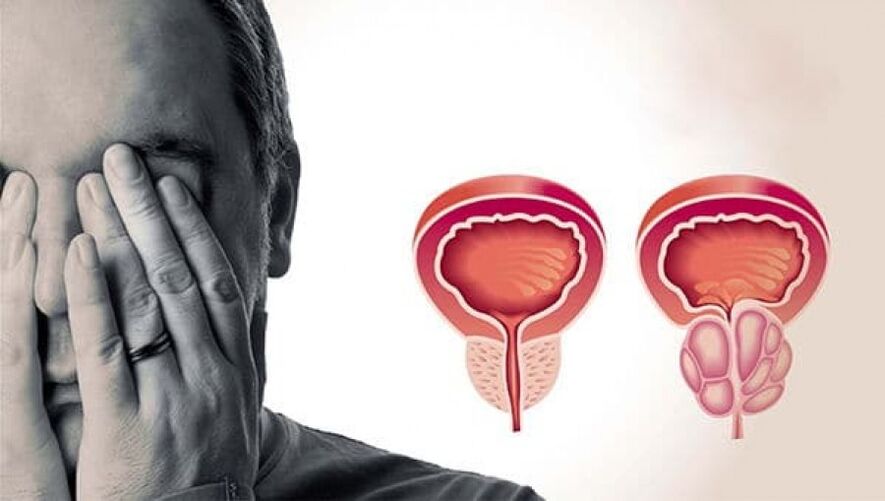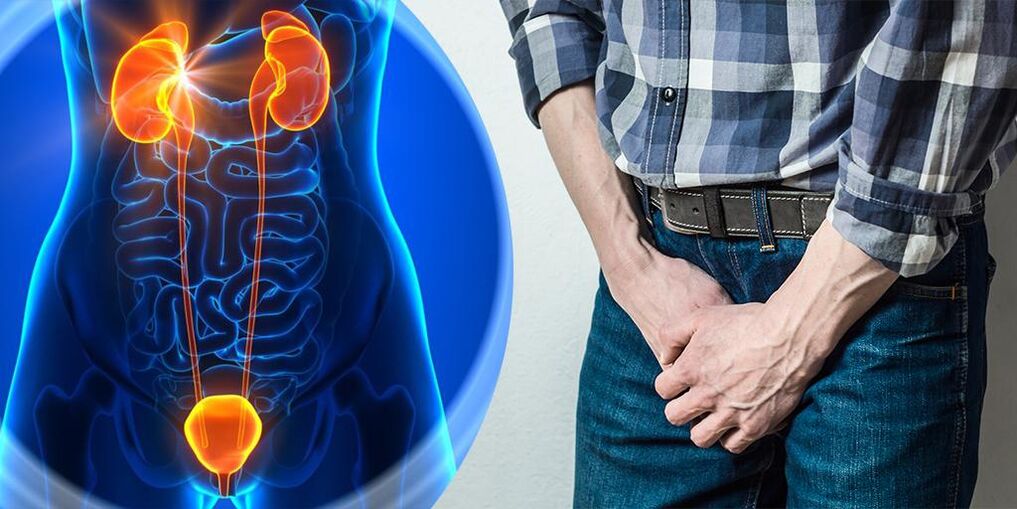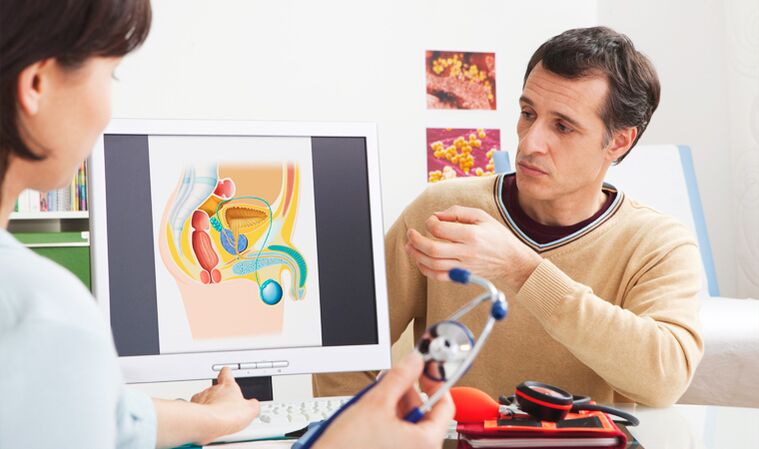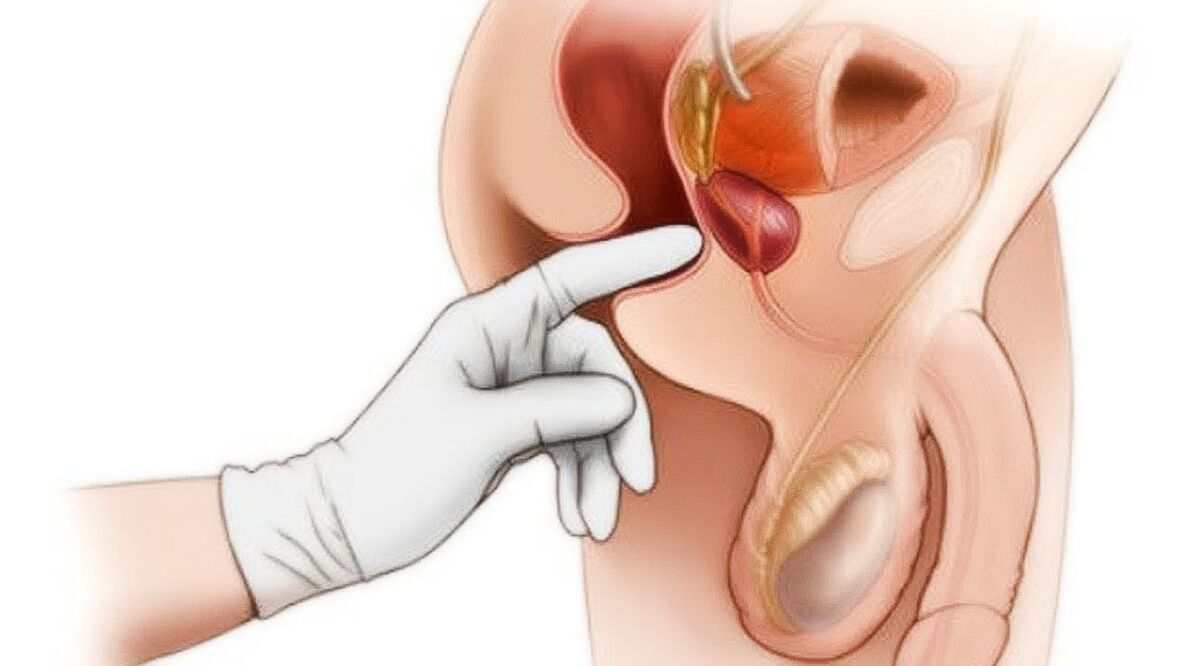More than half of the male population suffers from prostatitis. This disease is characterized by the development of the inflammatory process in the prostate gland. The disease proceeds acutely or chronicly. It occurs in young men of 20-45 years. But not everyone knows how prostatitis manifests and why inflammation develops. A frivolous attitude towards the disease makes it one of the most common among men.

Causes of the disease
The inflammatory process in the prostate occurs more frequently at the bottom of a bacterial infection. There are no exact causes of prostatitis, since the probability of inflammation of the prostate tissue increases with the weakening of immunity. The pathogens of the pathology can be staphylococci, E. coli, enterococos, pseudomonas.
These infectious agents are in the mucous membranes and the skin of a healthy person, but can cause the development of the inflammatory process in case of predisposing factors:
- Infutable sex life: rare sexual contacts, sexual acts interrupted with incomplete ejaculation;
- hypothermia;
- sedentary lifestyle;
- stagnant phenomena in pelvic organs;
- frequent urological diseases, sexually transmitted infections;
- stress;
- Use close clothes by pressing a man's genitals;
- chronic alcohol poisoning, drugs, chemical agents;
- crotch injuries;
- Reducing immunity.
The main symptoms of prostatitis depend mainly on the form of the disease (acute, chronic). It is recommended that the inflammation of the prostate be treated in a timely manner, otherwise, the disease will last and periodically give relapses. Therefore, each man must know how prostatitis begins and what signs should pay attention in the first place.
Etiology of chronic prostatitis
Chronic prostatitis develops in the context of acute prostate inflammation. During the referral period, man is concerned about weak pain in the perineum, intensifying during urination, defecation and intimacy. Urethra's minor mucous secretions may appear in stress.
The causes of the exacerbation of chronic prostatitis can be any factor: stress, forced restriction of emptying the rectum or bladder, the use of narrow lower linen, floor infections. During exacerbation, pathological characteristics can only increase slightly, manifesting in high body temperature and insignificant hyperthermia. Men who suffer from chronic prostate inflammation are subject to frequent relapses of the disease. As a reason for the development of the disease, even short -term stagnant phenomena in the pelvis can act.
Forms and symptoms of acute prostatitis
The signs of prostatitis in men will be present depend on the form of the disease. Acute inflammation in the gland appears primary. The disease has three forms: catarral, follicular and parenchyma. The latter is the most difficult. Men often do not know what symptoms with prostatitis talk about the beginning of the development of the inflammatory process.
So what signs of prostatitis should pay special attention? The initial manifestations of the disease:
- Pull pain in the perineum and the pubic;
- discomfort during urination, after intimate contacts;
- brokenness, weakness;
- A slight increase in temperature.
The catarrral stage of inflammation of the prostate is considered the easiest, but the treatment at home is contraindicated. Processing can lead to the development of a chronic inflammatory process. You cannot use tips for healers or acquaintances without a prior consultation with a doctor, since, as the most effective and correct treatment, a urologist can prescribe.
Folic inflammation occurs more acutely. Strong pains in the crotch and penis occur, unpleasant sensations can cover the entire lumbar region. The main feature of this form of prostatitis in men is a painful pain that does not allow the rectum and bladder to completely empty. In the context of this type of inflammation of the prostate, acute urinary retention and patient quality are interrupted. With an inopportune treatment, the disease can go to the next stage: parenchyma.

Parenchymal form of the disease
Prostatitis symptoms in men in a parenchymal way:
- serious condition of the patient;
- At the beginning of the disease, fast urine moves quickly to dysuria (complete urinary retention);
- The appetite is reduced, the patient is tormented by thirst;
- flatulence, the inability to empty intestines due to severe pain;
- The mucosa discharge of the rectum may appear;
- Body temperature increases, remains within 39 ° C.
One of the signs of prostatitis in men in this severe way is the acute pain of the prostate gland when probe. The patient's stick exam at this stage of the inflammatory process is difficult due to a serious condition and uncomfortable sensations in the genital area. If the qualified treatment does not begin at this stage, the disease can be complicated by the transition from the infection to the neighboring organs, the appearance of an abscess or the development of a chronic inflammatory process.
If acute inflammation is developed in the context of urethritis, urolithiasis and other pathologies of urinary organs, then the impurities of the blood, pus may appear in the urine, often experts find protein traces. With urine delay, urgent medical care is required. The disease is characterized by an acute beginning with a deterioration in general well and intense pain in the pubic area. Body temperature generally increases. The appearance of joint and muscular pain is possible in the context of severe poisoning.
The course of chronic prostatitis
When the symptoms of chronic prostatitis appear, men do not always go to the hospital. The painful pains can be transferred with relative ease and patients are not in a hurry to consult a urologist. Although chronic prostatitis in a man has less pronounced symptoms than an acute form of inflammation, the disease directly threatens with the patient's reproductive and sexual skills. And the treatment of the chronic form of pathology is longer, and in some cases even requires surgical intervention.
Prostatitis symptoms in chronically:
- Pain pain, painful pain, located on the pubis, in the perineum, tend to increase during urination, after sexual relations;
- Lightly difficult oriing, the intermittency of a current of urine is the main symptom of chronic prostatitis;
- the emergence of discharge of the urethra after the hard work or defecation;
- deteriorated sexual function.
In chronic prostatitis, the temperature generally remains normal. But during exacerbation, the appearance of febrile syndrome is possible. Typically, the temperature of 37 degrees with prostatitis indicates a slow inflammatory process. It is dangerous enough, especially for the reproductive health of a man.
Chronic inflammation proceeds more imperceptibly, manifesting, usually only with frequent urination and a violation of an erection. Remissions are replaced by relapses, but many men prefer not to treat their delicate problem with a urologist, indicating an extremely irresponsibility. The disease even in young men can cause infertility, and at an advanced age, the symptoms of inflammation of the prostate are sometimes hidden from prostate cancer.

Diagnostic methods
When men have the first signs of prostatitis, the urologist performs an external examination, explores the prostate through the rectum, determining the dimensions of the affected organ, its structure and density. During palpation, the doctor's movement must be as careful as possible.
Additional diagnostic methods for symptoms of inflammation of the prostate in men:
- Study of the prostate secret;
- laboratory diagnosis;
- PCR research;
- Prostate ultrasound;
- Uroofloometry;
- Magnetic resonance, computed tomography of the pelvic organs.
It is recommended to undergo an exam as soon as signs of inflammation of the prostate appear. This will avoid complications, among which erectile dysfunction, hyperplasia and infertility are often found. The study of the causes and symptoms of prostatitis is in the urologist's competition. It is for him that it is worth contacting even the minor signs of prostate disease.
Treatment characteristics
Many patients make a common mistake: they begin to use popular remedies, delaying the development of the disease and increasing the risk of complications. The treatment regime is strictly selected individually, only after determining the pathogen and determining the true cause of the development of inflammation with the termination of the damage factor: smoking, pyelonephritis, violation of erection, hypothermia.
The inflammation of viral etiology is treated using antiviral drugs. The inflammation of the prostate caused by clamidia infection requires taking antibacterial medications. A lot of attention is paid to the strengthening of immunity.
In no case should the treatment be treated at home, since it is impossible to cure the disease acutely with the help of traditional medicine. The chronic inflammatory process requires the intervention of experienced specialists. Modern treatment medications allow you to quickly and effectively relieve the inflammatory process and avoid the development of dangerous complications.
Drug therapy
The following funds are used to treat prostate inflammation:
- Antibacterial, antifungal, antitrichomonna drugs (depending on the cause of disease development);
- antispasmodics, analgesics;
- Physiotherapeutic methods.
Therefore, urologists recommend contacting doctors as soon as the first signs of prostatitis occur in a man. This will win time. The treatment with makeshift media, at home, is strictly contraindicated.
Each man with prostate diseases requires effective urological attention. Qualified Urologists use proven drugs and modern therapeutic methods. In the treatment, antibacterial drugs are used that easily penetrate the prostate tissue. During intoxication, special therapy is indicated.
Physiotherapy treatment is also used. It is used when prostatitis disease signs do not reach nothing, as well as relapse prevention. Any technique used by specialists must be selected taking into account the individual characteristics of a man's health status.

Prostate massage
Patients with chronic prostate inflammation massage gland. This procedure must be carried out only by experienced specialists, since it is a powerful treatment agent that improves the exit of the purulent inflammatory secrets of the ducts.
The prostate massage refers to a complex treatment and diagnostic procedure, which professionals should only carry out. It is carried out through the rectum. The organs of the organ are massage with fingers, stimulating blood circulation and the output flow of the prostate secret, whose study is required for many diseases of the genitourinary sphere. The massage releases the ducts of the accumulation of PU, eliminates the stagnation, reduces the manifestations of the inflammatory processes.
Possible complications
If you do not pay attention to the signs and symptoms of prostatitis, the infection is possible to other organs of the pelvic region, intense pain with urine and the appearance of blood and pus in the urine and pus can occur. In a careless way, temperature with prostatitis in men increases, it worsens work significantly.
The main complications of prostatitis:
- Vesiculite (inflammation of seed bubbles);
- prostate sclerosis;
- Prostate abscess;
- prostate cysts;
- sterility;
- impotence;
- Purulent infections of neighboring organs.
Any of the complications can interrupt reproductive function, cause sexual disorders. Chronic inflammation is especially dangerous. In context, urethra structures often arise, the qualitative and quantitative indicators of the seminal fluid are reduced. And this threatens the development of infertility in the future.
But the most formidable complication is considered gland hyperplasia with an increase in the risk of growth of malignant tumors. A man often does not even know about the growth of adenoma and cancer neoplasms until they reach impressive sizes and there are no difficulties in the urine.
Preventive measures
The prevention of inflammation of the prostate gland aims to eliminate the influence of negative external and internal factors. It is recommended to avoid unprotected sexual contacts, which leads to the development of sexually transmitted diseases complicated by damage to prostate tissues, as well as hypothermia and radial effects on the body.
Rejection excessively close pants and underwear, which squeezes the pelvis. Stagnation processes in genitourinary organs contribute to the active reproduction of pathogenic microorganisms, the development of infectious diseases. It is also important to empty the bladder in a timely manner. One of the prevention methods is measured and regular sexual life. Long -term abstinence leads to blood stagnation, causes an inflammatory reaction.
The early appeal to the urologist with the first clinical manifestations of the prostate diseases allows it to prevent the chronic course of inflammatory processes and dangerous complications. It is much easier and easier to treat acute prostatitis than dealing with a prolonged course of the disease.























